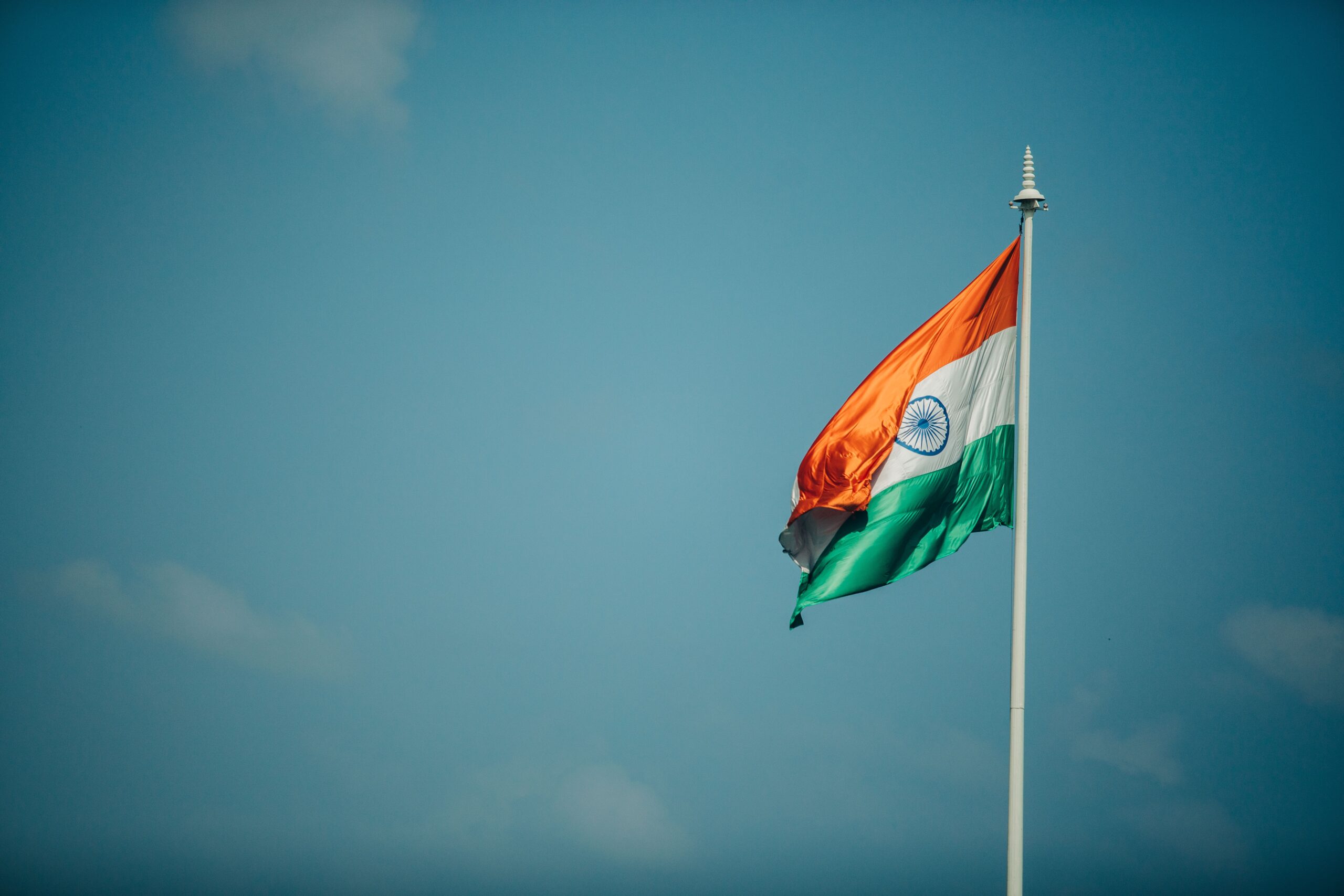On the 20th of November 2020, the Ministry of Education released NEP-friendly revised guidelines for a flagship education policy: Ek Bharat, Shrestha Bharat (EBSB). Although not officially described as such, EBSB appears to be one of the latest iterations of citizenship education in India.
The policy pairs together schools in different states/UTs across the country: such as schools in Tamil Nadu and Jammu and Kashmir and Ladakh. Students in paired schools will then undertake several activities throughout the year which will teach them about the other state’s culture. The Ministry has released painstakingly detailed guidelines of how teachers and bureaucrats can realise this: schools are to host skits, plays, debates, and workshops on the paired state’s festivals, foods, languages, histories, and peoples. Throughout the year, students get to learn about what life looks and feels like in another state. In the interest of fostering a (much-needed) intrinsic curiosity to learn, these activities will not be graded or assessed.
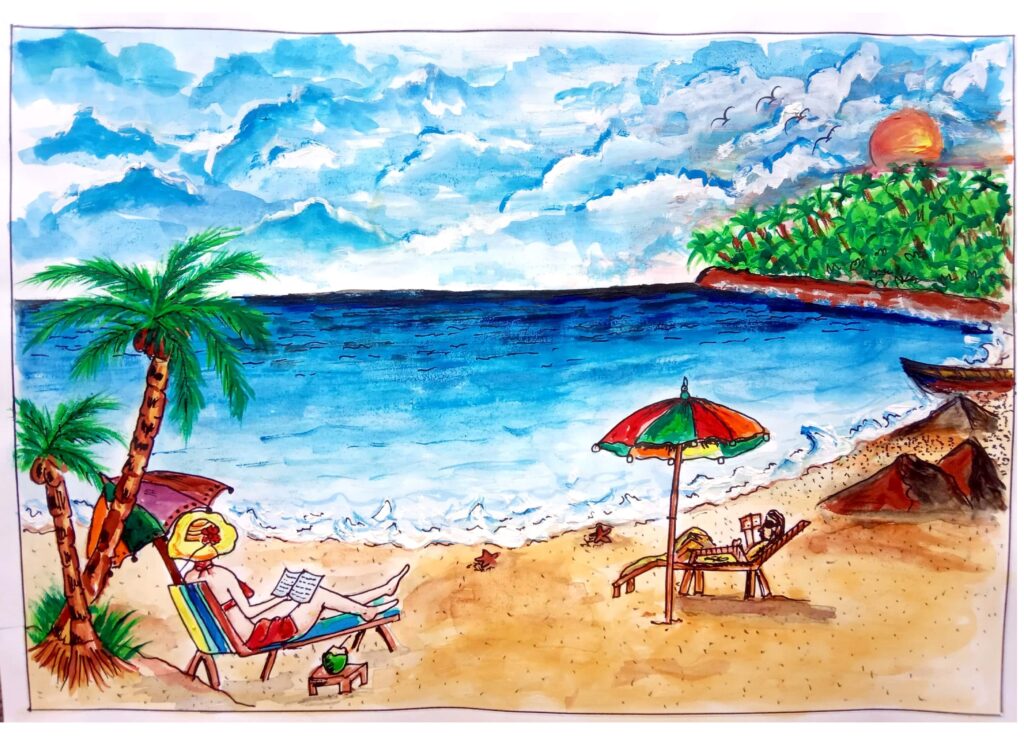
EBSB was launched by the Prime Minister on the 31st of October, 2015 — the 140th birth anniversary of Sardar Vallabbhai Patel. The policy is rooted in the belief that if students recognise the different ways that one can ‘be Indian’, they may better resonate with people and ideas that are fundamentally different from their own. In the policy’s own words, this makes people aware of the “seamless integral hull of the Modern Indian State spread across a vast landmass on whose firm foundations, the geo-political strength of the country is ensured to benefit one and all,” while at the same time, easing out the “feeling of [being a] ‘stranger in a strange land’” that some students may experience.
For its State-sanctioned support for Indian multiculturalism, the objectives of the EBSB deserve a hat tip — albeit a faint one. After all, this policy on enabling ‘Indianness’ for students contains not one mention of the term ‘secular’.
Nevertheless, like legions of civics and politics textbooks and curricula before it, the EBSB doesn’t provide space for why these sentiments are developed in the first place — it assumes a solution without outlining the problem. Alienation cannot be sufficiently countered by a debate, textbook, or skit included in a citizenship education curriculum — especially when ‘different’ groups of citizens are regularly demonised by the media and politicians alike. A deep dive into India’s histories of citizenship education pedagogies reveals why they may fail in their endeavours to really teach citizenship to Indian students.
What Is Citizenship Education?
Civic education, developed by the Central and state governments, teaches us how to understand states and societies. It is also a form of citizenship education, which directly supports “students’ development of [national] identity.” Simply put: your specially designed civics textbook or education policy tells you what the government thinks you need to know about being an Indian citizen. However, the government may not want you to know too much about the radical powers of democracy.
“One can see that the texts are terse in nature and have a Constitution-centric or legalistic approach. They fail to critically evaluate and blend the ideas or perceptions children gain from experience with what the textbooks want to teach in the legalistic framework. By sticking to this framework, the textbooks manage to keep “politics” completely outside the civics education.”
That’s Alex M. George, who in Children’s Perception of Sarkar, provided a well-researched critique of civics textbooks from the 1980s and 1990s in India. George’s bottom line: formal civic education in Indian often only superficially describes India, in terms of its institutions and cultures. The realities of being a citizen — which are messy, and shaped by public opinion, dissent, and resistance — often fail to make the cut.
So, if democracies and governments are built by public opinions and action then why do even these aspects of civic life fail to find serious mention in our textbooks?
More importantly, is the absence of such content important at all? Do children really need to learn about such issues? The answers to these questions depend on the larger priorities of the system. “If our desired learning outcomes are to repeat what an authority has said to us, then our education system hasn’t failed,” says Dr. Manish Jain, Associate Professor at the School of Education Studies, Ambedkar University. “Rather, it is operating rather successfully.”
George’s findings aren’t outlandish. Think of the civics textbooks you leafed through in school. You probably came across discussions of ‘unity in diversity’, where different cultures from Kashmir to Kanyakumari would be described. However, how many chapters did you have on anti-government protests that redefined India’s government, like those against the Emergency? Were you ever asked to apply the theory of fundamental rights to real-life situations? As George notes, “the way in which society subverts and reorganises state-society agendas” was totally ignored in many of these textbooks.
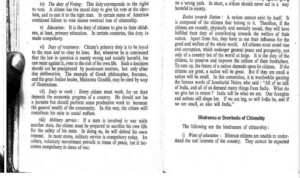
A Partial History of Citizenship Education in India
As seen in the activities listed under EBSB, citizenship education in Indian schools can take varied forms beyond textbooks. Even if you never took civics or democratic politics as a subject, chances are that you have still participated in activities which are designed to educate you on India and Indianness. This is because “Education, for long, has been involved in creating citizenship [of students],” says Dr. Shivali Tukdeo, Associate Professor in the Education Programme at NIAS, Bengaluru. “Through reciting the national anthem and the pledge, the messages of national unity and integration were made part of everyday schooling.”
You May Also Like: Indian Students’ Silent Hymns: Of Sanskrit Prayers in Secular Schools
And so, much like the textbooks in George’s study, these daily rituals subtly educate students on the different building blocks that make up the Indian nation — be it concrete concepts like states or languages, or intangible ones like democracy or federalism.
However, much of what we recognised of ‘modern’ India today was designed in a colonial past, much like these citizenship education practices, imbibed at school every day. They reinforce an idea of citizenship that is neither assertive nor informed; rather, it is one that is tailored to the interests of larger, insecure power structures.
These ideals stem from the fact that during the colonial period, “the State was largely seen to be paternalistic, as one that could do no wrong. There was no space for critiquing it”, says Dr. Jain. “Instead, if there were any shortcomings [witnessed in society], these were attributed to the shortcomings of the morals and political characteristics of the citizens instead. And so, the focus of citizenship education was to reform the citizens — here, the State was in a pedagogical relationship with the citizens to teach them how to be good. These are ideas we inherited post-independence too.”
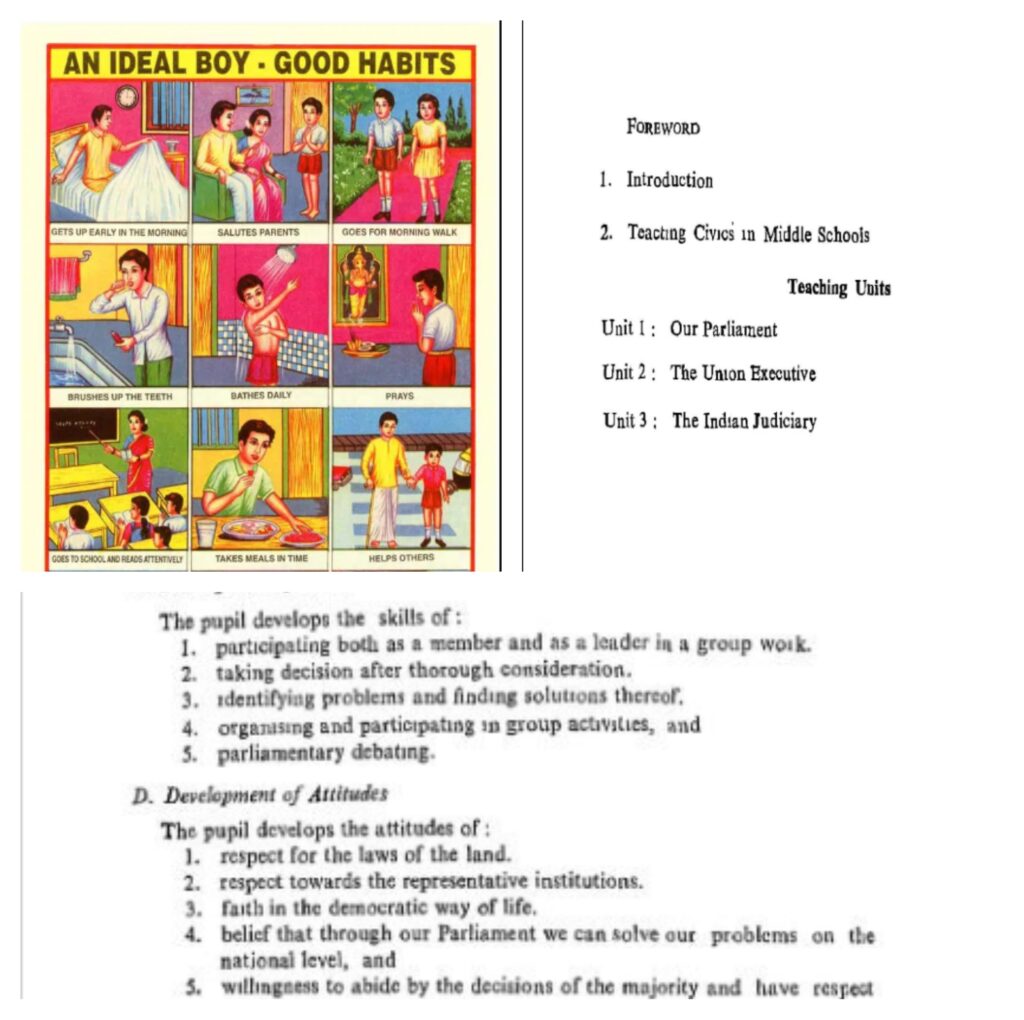
The reasons such ideas were preferable for authoritarian, yet insecure colonial governments are fairly obvious: they cement the authority and legitimacy of the State in the minds of its citizens, making challenging it’s ‘good intentions’ seem unpatriotic, and thus bad behaviour for any loyal citizen to perform. Post-independence, the newly-formed Indian State stood on similarly fragile ground. “The outcome of the 1947 partition was that India was born a democracy,” says Dr. Jain. “The question of ‘how will we survive?’ as a nation as the decades progressed became very important.”
Perhaps such fears were not unfounded. By the mid-1960s, India was yet to heal from the communal wounds of the Partition, had fought two wars, and faced a colourful array of separatist movements and insurgencies. Within these times and spaces, education, and specifically citizenship education, became a key tool to remind students of what this newly-minted country stood for. That the National Council of Educational Research and Training (NCERT) — the body that designed the textbooks for CBSE or ICSE schools — was formed in 1961 is telling of the need to institutionally legitimise the Indian State within classrooms.
During this period, the brand new civics textbooks emphasised a formalistic form of citizenship, detailing the role of the State institutions that citizens engaged with such as the judiciary, executive, and legislature. However, even within this, “there was little focus on how citizens experienced these aspects of the State,” says Dr. Jain. “The focus remained on unity on diversity, wherein different cultural identities were subsumed under the national identity. This became a key feature of how citizenship education was formulated in India.”

George pointedly describes one more feature of this pedagogy bearing colonial undertones: that there was an “unwillingness of the textbooks to deal with (..) the political values and culture that operate outside or away from the legalistic, constitutional framework. These political values and culture constitute the elements which, in practice, affect and modify these institutions and concepts and thus take away the purity of their idealistic form.”
Citizenship education in the 21st century
The priorities of the current State infrastructure — one that has been in part due to an unchanging nationalist mindset — may also be to continue this state of affairs. What is different about India now, especially post 2014, is that rigorous learning lessons over citizenship take place outside the classroom more than they do inside of it.
Take this example from the Netherlands as a parallel. Researchers studied the effectiveness of Dutch citizenship education being taught to a class of non-migrant Dutch students and Dutch students of migrant backgrounds. Students were asked to discuss the curricula in class, to understand more of each group’s conceptions of national values.
Conflicts arose between the two groups of students: non-migrant Dutch students viewed liberal ‘Dutch values’ (such as freedom to sexual identity) as values intrinsic to the Dutch national identity, and thus as integral to their personal identities too. They projected biases in their discussions on the ‘outsider’ migrant Dutch students — based on their ethnic and religious backgrounds, these students were perceived to be intolerant to ‘Western’ Dutch values. According to the researchers, these conflicts in the discussions were “verbalized in terms of this ethno-nationalist discourse in media and politics with frequent references to statements by politicians in the media.”
The situation of media and public level discourse is no better in India. Definitions of good v/s bad citizens are now publicly, poisonously, and pervasively produced in battles between nationalists and ‘anti-nationals’ across states. Ironically, these disputes over who is a ‘real’ Indian largely happen between dominant and minority cultures — in spite of the State’s overtures that all Indians are equal citizens regardless of their backgrounds.
Karnataka school run by RSS man makes kids ‘demolish’ Babri Masjid in a play
The Chief Guests for the event were Union Minister of Chemicals and Fertilizers, DV Sadananda Gowda; Puducherry Governor Kiran Bedi; and several Ministers from Karnataka. pic.twitter.com/hVdqxvfdvI
— Sanyukta (@dramadhikari) December 16, 2019
So, who is a student to believe then? Their curricula, which makes feeble attempts to engender sentiments of unity and equality with the ‘other’? Or, the deafening, partisan ideas shaping their worlds and governments outside of school?
If the point of an education policy is to produce specific learning outcomes for a subject — in this case, this would be a sense of citizenship of a united nation — then the ability of the EBSB, or indeed any superficially designed citizenship education policy to do so stands challenged. Citizenship education efforts have rarely made the effort to teach students what it really means to be a citizen of a value-driven democratic nation-state — students are instead left to learn these lessons outside of school, where the ‘good’ student, and prospective ‘good’ citizen, is uncritically defined and identified by whose side they’re on. George’s study, which comprises detailed interviews with students on how they understand their civics curricula, arrives at the same conclusion: “children often fail to identify the relationships between various concepts (..) Given this fact, one can say that the textbooks fail to describe, explain and communicate many of the central concepts and issues regarding the nature and functions of the Sarkar.”
In the long run, this illiberal, extra-curricular understanding of ‘good citizens’ and ‘bad citizens’ bodes particularly ill for a real appreciation of the values and concepts that have defined modern India since 1947, and have been enshrined in the Constitution since 1950.
So, how do you teach citizenship? What do we teach in the first place?
To reinvent citizenship education then, one that instils a deep, experiential understanding of India and its complexities in students, we need to reorient the goals of our curricula. The next question then is how do we do this?
Education NGO Eklavya ran an innovative and enterprising Social Sciences Programme across eight government schools in Madhya Pradesh. The purpose of the program, rather refreshingly, was “to strengthen [the] conceptual understanding of the social sciences in children by using information to foster critical analysis of social processes.”
The program only ran from the 1980s to 2002, after which it was put to an end by the Madhya Pradesh government. However, this spirit of critical thought is visible in their curricular vision documents both in English and Hindi, as well as the PDFs of the textbooks online. The textbooks focus on some description of laws and institutions, however, force the student to apply them to the difficult realities and contexts of Indian society.
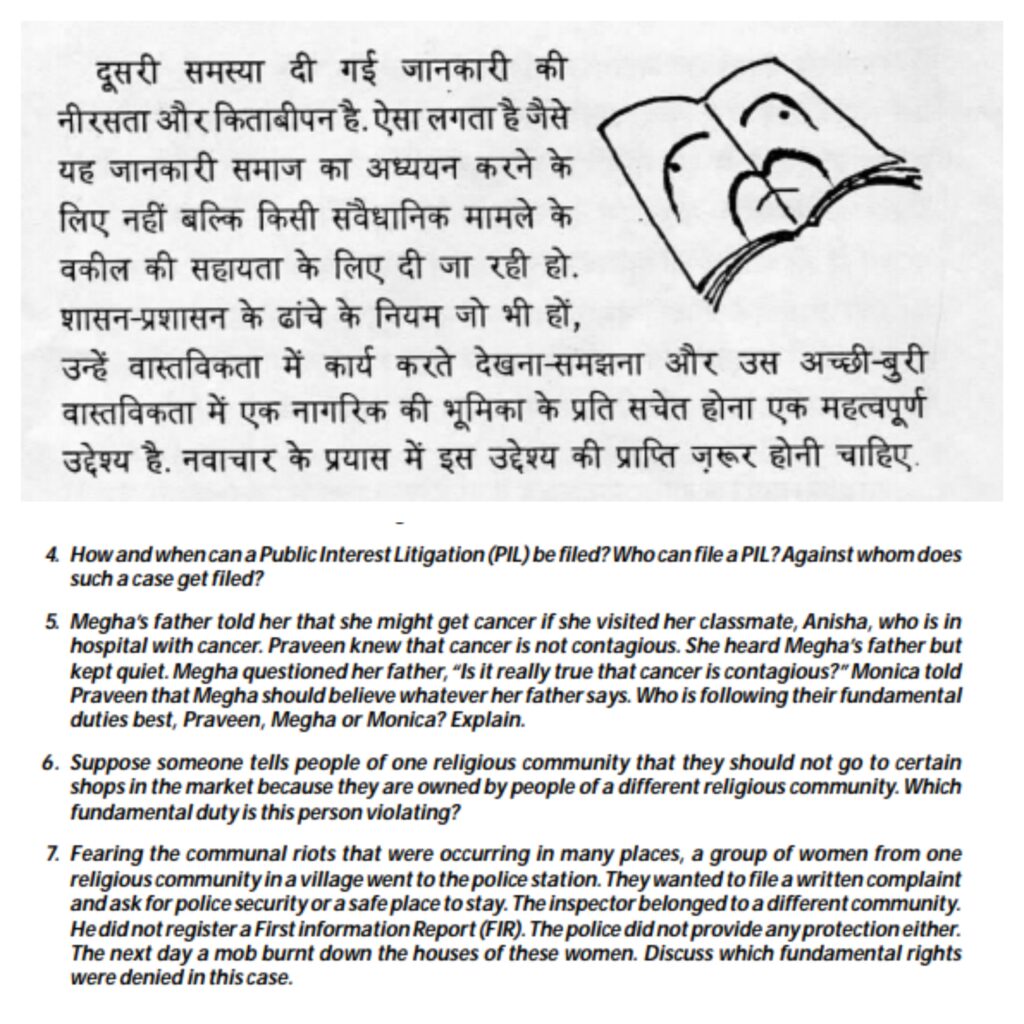
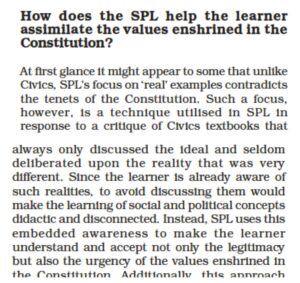
Or, teachers could take a leaf out of the diary of Upasna Sachdeva, a former Teach For India fellow, and simply talk about the complexities of Indian societies using hypothetical scenarios. Such practices, which “can help create awareness and build critical thinking skills with minimal prejudice (..) may also help develop the nuanced understanding that parties and people are a summation of ideas, and are neither always right nor always wrong – something gravely missing in our polarised political mindsets today.”
In any case, to create a sense of citizenship within the fabric of India, dancing around ideas of cultural diversity, while necessary, simply isn’t enough to counter the vitriol circulating in the public sphere. It is also unlikely that the Indian state will sustain meaningful spaces for critical, nuanced citizenship education — inherently illiberal nation-states cannot espouse liberal values beyond a point. Perhaps the responsibility of reclaiming these discourses lies in the hands of the public, the very same one upon whose shoulders the canon of citizenship education has been raised.
Featured image courtesy of Big G Media on Unsplash. | The author thanks Vaishnavi Rathore for translation assistance.


